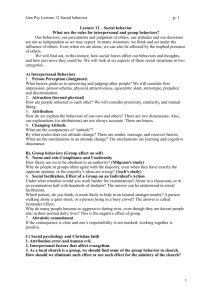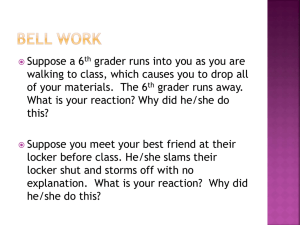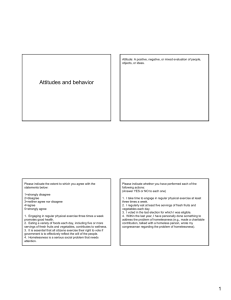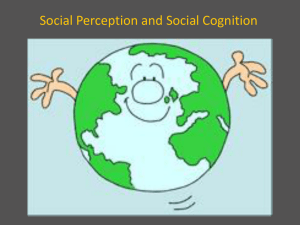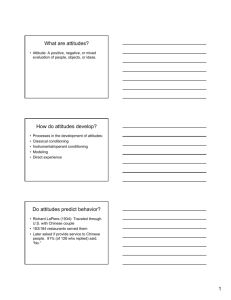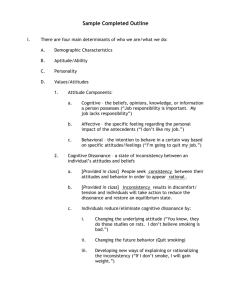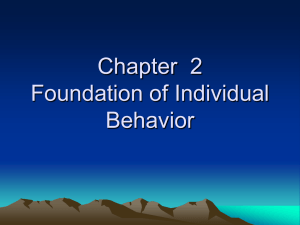Topic 8
advertisement
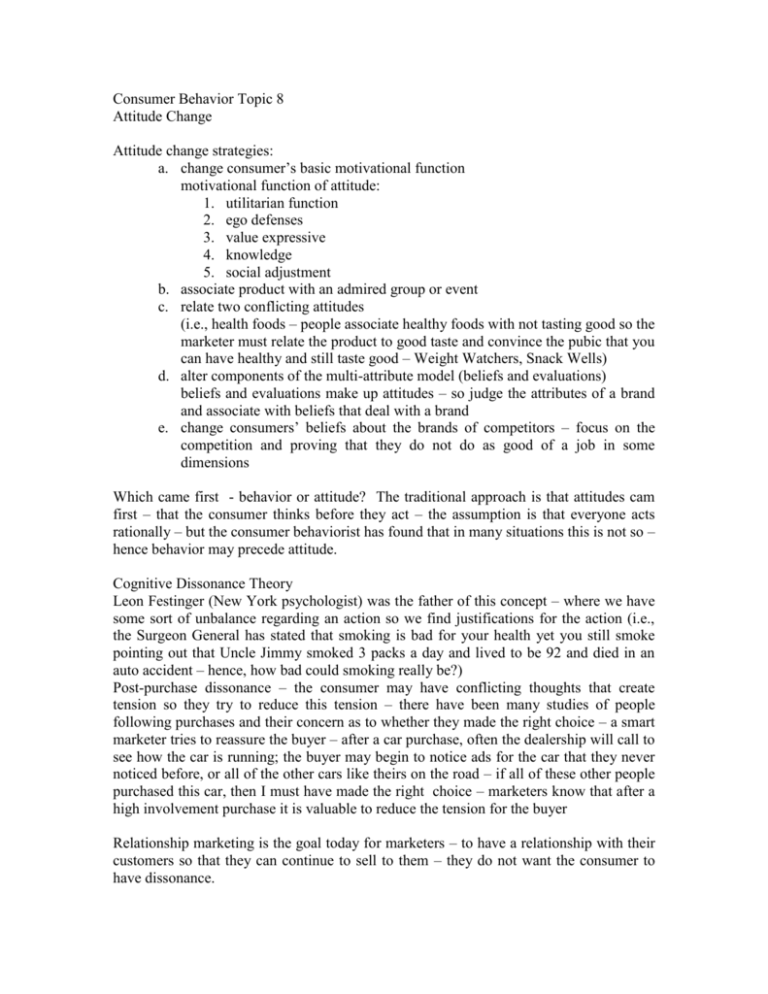
Consumer Behavior Topic 8 Attitude Change Attitude change strategies: a. change consumer’s basic motivational function motivational function of attitude: 1. utilitarian function 2. ego defenses 3. value expressive 4. knowledge 5. social adjustment b. associate product with an admired group or event c. relate two conflicting attitudes (i.e., health foods – people associate healthy foods with not tasting good so the marketer must relate the product to good taste and convince the pubic that you can have healthy and still taste good – Weight Watchers, Snack Wells) d. alter components of the multi-attribute model (beliefs and evaluations) beliefs and evaluations make up attitudes – so judge the attributes of a brand and associate with beliefs that deal with a brand e. change consumers’ beliefs about the brands of competitors – focus on the competition and proving that they do not do as good of a job in some dimensions Which came first - behavior or attitude? The traditional approach is that attitudes cam first – that the consumer thinks before they act – the assumption is that everyone acts rationally – but the consumer behaviorist has found that in many situations this is not so – hence behavior may precede attitude. Cognitive Dissonance Theory Leon Festinger (New York psychologist) was the father of this concept – where we have some sort of unbalance regarding an action so we find justifications for the action (i.e., the Surgeon General has stated that smoking is bad for your health yet you still smoke pointing out that Uncle Jimmy smoked 3 packs a day and lived to be 92 and died in an auto accident – hence, how bad could smoking really be?) Post-purchase dissonance – the consumer may have conflicting thoughts that create tension so they try to reduce this tension – there have been many studies of people following purchases and their concern as to whether they made the right choice – a smart marketer tries to reassure the buyer – after a car purchase, often the dealership will call to see how the car is running; the buyer may begin to notice ads for the car that they never noticed before, or all of the other cars like theirs on the road – if all of these other people purchased this car, then I must have made the right choice – marketers know that after a high involvement purchase it is valuable to reduce the tension for the buyer Relationship marketing is the goal today for marketers – to have a relationship with their customers so that they can continue to sell to them – they do not want the consumer to have dissonance. Research on dissonance One classic study asked a group of students, who were selected as other students looked to them as role models, to tell others why it was important to take shorter showers (i.e., save resources, save water especially during drought months etc.) – these students were then asked how many actually “practiced what they preached” and at that point only 55% actually did take shorter showers; to increase the dissonance, these same student role models were asked to discuss the value or shorter showers on videotape – once they had actually spoken about it they were then asked again if they were taking shorter showers and the results were 92% were in fact taking shorter showers – people like to hold consistent views Attitudes may changer after behavior – one do something and you think about it, you may have tension and then change behavior How brainwashing works – start with a behavior and see an attitude chance automatically so there is no dissonance – In the film The Manchurian Candidate, American soldiers are brainwashed by the Korean soldiers using a psychological technique – no torture was used – and a common technique used was having American soldiers, without cohersion, write essays to why communism is a superior form of government – once done, these soldiers often in fact did find communism superior to democracy Defensive attribution – if we see something horrible that happens to someone else, we may say that is was something that they did to bring it on (i.e., classic claim regarding rape was that the “woman was asking for it” by doing something or wearing something provocative) – this is the way we explain to ourselves the setbacks that befall other people – an internal attribution – we do so as not to think it will happen to us – to say that is was not random (which could happen to us) – by blaming the victim Self Perception Theory Sometimes people look at themselves and try to figure out why they did something – here attitude comes after behavior – If I did this then it must mean that this is my attitude… Foot-in-the-Door – a technique used to change peoples’ behavior – articles written to prove that it works – the original study asked houses randomly in a community to sign a petition in favor of safe driving (something simple that everyone believes in, even if they are not interested in it) and then come back later and ask for something larger such as placing a sign in their yard for safe driving – it was found that among the group who signed the petition more were willing to allow the sign than those not asked on the first round – the reason? Once you do something small, your brain starts working – Why did I sign this? It must be because I believe in this. Door-in-Face – the opposite technique – ask or something monstrous and the door gets closed in your face but then come back and ask for something stronger and often the person will have thought about it and agree to the smaller request Attribution – internal and external Internal: a. more consistency over time b. more consistency over modality c. lower degree of consensus d. greater degree of perceived decision freedom e. higher the perceived behavioral desirability How we test our attributes: 1.distinctiveness – this only happens when certain person are there – that is, these people cause the misfortune so you attribute your misfortune to these people; it is distinct in that this is the only time such and such happens 2. consistency over time – every time we see something happen, there is something consistent that happens – such as, using a certain product and always get sick so you say it is due to the product, or food or season etc. 3. consistency over modality – if you offer your friend sushi and each time they decline, you eventually will decide that thi person does not like sushi but this is not necessarily so 4. consensus – if fail, due to an attribution – blame self but if everyone fail, then it is the teacher’s fault 5. perceived decision freedom – think have lots of choices, such as a celebrity who chooses to endorse a particular product – you perceive that they can endorse lots of product yet selected this one 6. perceived behavioral desirability – a foot of snow yet you make it to class – you think this says that you like the course to the professor Over justification effects – in studies have 2 groups of children do things that they like to do – then have one group rewarded for having done so and the other not rewarded – several weeks later who is more likely to do the work without a reward? Clearly the group ho was not rewarded the first time – when given a reward, the mind will say “who do this without a reward? “ It is dangerous to reward people for doing things that they would normally do – the brain may begin to expect rewards for work = over justification. Don’t always reward. In marketing when premiums, prizes or gifts are continually given (cereals, Cracker Jacks) then the brain says “don’t buy” unless the expected prize is there One application of attribution theory: Why do this? Because of the reward – but would have done it anyway Other findings from attribution theory: if brand claims superiority on all attributes then people will think that this is too good to be true – it is better to “disclaim superiority” on one or two attributes – this makes a better ad The same theory holds when a celebrity endorses too many products – their credibility goes down – vs. when they just endorse one product and they seem more sincere and believable.

